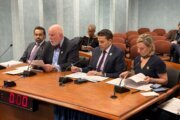The Associated Press
Excerpts from recent editorials in newspapers in the United States and abroad:
___
Oct. 24
The Daily News, Bowling Green, Kentucky, on U.S. benefiting for Nazis being an outrage:
Those who have committed war crimes or who are suspected of committing them must answer for them.
War criminals kill innocent people for various reasons, whether it’s over religion, ethnicity or ideology. Whatever their reasons, there can be no justification for their actions.
One of the most well-documented and horrendous cases of war crimes occurred during World War II when former German dictator Adolf Hitler and his henchmen tried to exterminate the entire Jewish race along with others they considered inferior or undesirable. Because of their orders and orders being acted upon by leaders and soldiers in the concentration camps, nearly 6 million innocent Jewish people were murdered.
There are a few officers and guards from those concentration camps who are still alive and have evaded capture or trial for their despicable acts.
To add insult to injury to the families of victims massacred in the camps, it has been disclosed that dozens of suspected Nazi war criminals and SS guards received millions of dollars in U.S. Social Security benefits after being forced out of the United States.
The payments, underwritten by U.S. taxpayers, flowed through a legal loophole that gave the U.S. Justice Department leverage to persuade Nazi suspects to leave the U.S.
If they agreed to go or simply flee before deportation, they could keep their Social Security benefits.
There is a lot of blame to go around here, but the bottom line is these men are suspected war criminals who need to be tried for their alleged crimes in a court of law, rather than receiving money from U.S. taxpayers.
Shame on those who were responsible for letting this happen. Perhaps this injustice can still be corrected.
Online:
http://www.bgdailynews.com
___
Oct. 24
Morning News, Savannah, Georgia, on citizen jihad:
Two recent terrorist attacks in Canada by lone jihadists with ties to radical Islam show what civilized nations are up against in the fight against the Islamic State.
Wednesday’s attack on Canada’s Parliament that left one soldier dead and another three days ago that killed a soldier in Quebec appear to be the work of “lone wolves” — psychos who are inspired to kill, ostensibly in the name of religion.
Welcome to the twisted, dangerous world of citizen jihad.
If you can’t make it over to the Middle East to kill someone in the name of Allah, do it at home. Look for inspiration on social media.
Michael Zehaf-Bibeau, a 32-year-old Canadian Muslim of Algerian descent, was the shooter in Ottawa. Martin Couture-Rouleau, a 25-year-old recent Muslim convert, killed a soldier in a hit-and-run assault in Montreal.
While the Canadian government has not confirmed a direct link between the two men, it’s not really necessary. What is known is that the Islamic State has put out a call for its sympathizers to kill citizens of nations that are battling ISIS. That includes Canadians as well as Americans.
“If you can kill a disbelieving American or European, especially the spiteful and filthy French, or an Australian, or a Canadian, or any other disbeliever, then rely upon Allah and kill him in any manner or way however it may be,” urged a speaker on a video Islamic State released last month.
It’s noteworthy that a Twitter account linked to Islamic State tweeted out an image of Zehaf-Bibeau, even as the international media was scrambling to identify him. It takes a terrorist to know a terrorist.
For organizations that hope to sow fear, these lone wolves offer cost-effective ways to strike. They don’t have to hijack a plane. Just grab a gun.
Zehef-Bibeau made it deep inside the government building before the parliamentary sergeant-at-arms — a decorated veteran of the Royal Canadian Mounted Police — put him down with his service pistol.
If more citizen jihadists crawl out from under rocks, expect this outcome to be rule. Not the exception.
Online:
http://savannahnow.com
___
Oct. 28
Los Angeles Times on E-Verify having a future:
Whatever comprehensive immigration reform plan finally emerges from Congress will almost certainly make it more difficult for future immigrants to enter the country illegally — and, if they do, will make it harder for them to stay. One of the likely mechanisms of that is the E-Verify hiring database, which is designed to keep illegal immigrants from working in the U.S. Since it was introduced, E-Verify has been a deeply flawed system, and this page has opposed its expansion and mandatory use. Now, though, some of its problems are being fixed.
E-Verify determines whether job applicants are legally eligible to work in the U.S. by checking their names against databases kept by the Social Security Administration and the Department of Homeland Security. Unfortunately, in its early iterations, the system both failed to detect illegal workers more than 50% of the time and, in far too many cases, wrongly denied eligible applicants the right to work.
That may be changing. U.S. Citizenship and Immigration Services recently rolled out an updated self-check system called myE-Verify, which allows workers to edit their profiles in the E-Verify database and challenge information they believe to be inaccurate. It includes a component called Self Lock through which individuals can “lock” a Social Security number. If someone tries to get a job using your number, both you and the potential employer will know. Although it is only available in five states and Washington, D.C., this is clearly a step forward.
But it also moves the country closer to a more nuanced set of problems. Five states require employers to use E-Verify, and an additional 13 require that it be consulted for state employees or, in two cases, employees of state contractors. More than half a million employers nationwide use the database, many of them voluntarily. But as the program expands, illegal immigrants who have been here for years and might be eligible for an eventual path to citizenship could lose their jobs and face deportation.
This is a conundrum. This page believes people who enter the country illegally do not have a right to work. But we also believe that as part of a comprehensive immigration reform plan, immigrants who have been in the United States for a long period of time, have established roots and avoided legal trouble should be eligible for a path to citizenship. Most immigration reform proposals include such provisions, including the Senate’s 2013 bill, which the House has not voted on. According to one analysis, 60% of the estimated 9.6 million deportable adults in the country have been here at least 10 years. They are among the people jeopardized by E-Verify.
E-Verify may ultimately become a useful tool to help control illegal immigration. But it doesn’t make sense to expand it nationally or make it mandatory until the country has decided what to do with the enormous population of illegal immigrants already here. That’s why E-Verify should be a part of comprehensive immigration discussion, not a one-off policy that creates more problems than it solves.
Online:
http://www.latimes.com
___
Oct. 29
Boston Herald on CDC adding to confusion with Ebola:
A month after the first case of Ebola was diagnosed in this country, the Centers for Disease Control on Monday announced yet another policy for dealing with the dread disease and people who have been exposed to it while in West Africa. Meanwhile, U.S. Army leaders have adopted their own quarantine policy for returning military personnel and the governors of at least six states are imposing their own restrictions.
In short, the Obama administration has failed miserably to bring order out of the chaos of conflicting policies and it’s every government agency for itself.
A Pentagon spokesman has confirmed that all soldiers returning from West Africa (the U.S. has committed about 4,000 troops to the fight against Ebola there) will be isolated and monitored for the 21-day incubation period of Ebola.
The governors of New York, New Jersey and Illinois (all among the five newly authorized gateway entry points for those arriving from West Africa) were joined by Florida, Minnesota, Virginia and Maryland in announcing varying degrees of quarantine for new arrivals.
Those announcements came in the wake of the hospitalization of Dr. Craig Spencer, who had just returned from treating Ebola patients in Guinea under the auspices of Doctors Without Borders. Yes, Spencer was doing heroic work and he did the right thing by monitoring his own temperature twice a day and reporting to the emergency room when he developed a fever. But he also violated CDC protocols by traveling on public transportation (three subway lines), dining out and going bowling during the incubation period.
This latest effort by the CDC calls for those with direct exposure — such as a needle stick or unprotected contact with an Ebola patient — to avoid “congregate settings,” airline travel and public transportation. That is an exceedingly small number, and there’s no evidence that Dr. Spencer would have been included in the “direct contact” group.
So once again the CDC has come out belatedly with a policy that fails to address legitimate public health concerns. Now it is indeed every state for itself.
Online:
http://www.bostonherald.com
____
Oct. 30
Pittsburgh Post-Gazette on U.S. needing to end embargo on Cuba:
The rout of the United States in the annual United Nations vote on sanctions against Cuba was worse this year than last. On Tuesday, a nonbinding resolution condemning the U.S. economic embargo passed, 188-2, in the 193-member organization.
Israel was the only country to vote with the United States. Pacific island nation Palau, which had voted with the United States in 2013, abstained.
There is good reason for the United States to change its policy toward Cuba now, after 55 years of attempted isolation, even apart from the pariah status it earns Washington in Latin American and international affairs. For one thing, the policy hasn’t achieved its aim, toppling the Castro regime. Various U.S. elected officials, of both parties, had held out hope that the Castros would die or be overthrown, and that a regime less resistant to the United States would take its place.
Cuba also has not exactly thrived, since support from the Soviet Union ended with the fall of that regime in 1990. At the same time, the island nation has continued to earn the sympathy of Latin American countries. In particular, the government of late Venezuelan President Hugo Chavez provided Cuba with cut-rate oil, helping considerably.
Meanwhile, Cuba has behaved reasonably. For instance, it sent 250 doctors to West Africa to fight Ebola. Fidel Castro, the key figure in the revolution, stepped down as president for health reasons in 2008. His brother Raul, who succeeded him, has made changes that moved the country away from rigid Marxism toward policies that have made life marginally easier for Cubans.
President Barack Obama is unlikely to change the approach to Cuba before the midterm election. Nonetheless, there is evidence that even in South Florida, the former stronghold of anti-Castro Cuban-Americans, opinion is moving away from America’s failed embargo toward bridging the unnecessary gap between two neighboring countries.
Online:
http://www.post-gazette.com
___
Oct. 24
Seattle Times on another release from North Korea, that’s not Bae:
North Korea’s decision this week to free American Jeffrey Fowle revives hope for the release of former Washington state resident Kenneth Bae.
Bae, 46, is one of two Americans still held captive by the communist country. First arrested on Nov. 3, 2012, he is the longest-detained U.S. prisoner since the Korean War. The former tour operator and father of three was sentenced to 15 years of hard labor for allegedly plotting to overthrow the regime. In an Aug. 14 Time magazine report, Human Rights Watch denounced the decision as an overly harsh method of punishment.
On Tuesday, U.S. State Department spokeswoman Marie Harf said diplomats “remain focused on the continued detention of Kenneth Bae and Matthew Miller, and again call on the (North Korean government) to immediately release them.”
U.S. officials are actively engaged behind the scenes, but that is little consolation for Bae’s family in the Edmonds area. Family members just want Bae released so he can receive medical attention for serious back and heart problems.
In court, Bae admitted to committing the crimes he was charged with. Bae’s sister, Terri Chung, is hoping that will lead to Bae’s release soon.
“We know that the (Democratic People’s Republic of Korea) wants to be fair and has recently shown signs that it desires to engage with other nations,” Chung said in a public statement. “We hope DPRK leaders will have mercy on my brother to show goodwill to our family and to the world.”
Since the U.S. has no formal diplomatic relations with the North Korean government, Swedish diplomats are negotiating on its behalf. Harf says the Swedish diplomats played a major role in Fowle’s release. This continues to be a vital connection in communicating with Pyongyang officials, whose motives remain unclear.
The reclusive regime’s willingness to allow a U.S. military plane to enter and transport the 56-year-old Fowle out of the country — reportedly in exchange for nothing — is a promising sign.
Imprisoning Kenneth Bae serves no real purpose.
The next carrier out of Pyongyang should include the remaining Americans.
Online:
http://seattletimes.com
___
Oct. 28
Toronto Star on no reason to panic over Ebola:
With a spate of Ebola cases popping up in North America, including recently in New York, where a doctor rode the subway and went bowling before being diagnosed, there’s nagging public concern about the risk posed by the deadly virus.
People are right to pay attention. A case of Ebola might — and probably will — appear in Canada within the next few months. It’s a horrific disease, killing about half of those infected, and it’s out of control in parts of West Africa.
But the general public in North America has no reason for fear. Indeed, there’s probably more reason to worry about drug-resistant tuberculosis in the wake of a troubling World Health Organization report last week.
The evidence so far available about Ebola shows that risk in the United States and Canada is confined mainly to health care professionals. That’s understandable. The Ebola virus isn’t especially easy to contract. It requires direct contact with contaminated vomit, diarrhea, blood or other body fluid. Brave doctors, nurses, paramedics and other health care providers are far more likely to encounter such material than a person on the street. They care for the sick, bearing the burden of risk so that others stay safe.
Initial slip-ups in Dallas, which had the first case of Ebola diagnosed in North America, resulted in two nurses being infected. Both were involved in treating Thomas Eric Duncan, who arrived from Liberia without showing Ebola symptoms but who quickly fell sick and eventually died. Somehow, nurses Nina Pham and Amber Vinson were exposed to infected fluid.
Lessons were learned and procedures aimed at defending health care workers were tightened up, with special attention to safely removing protective gear. But these incidents have fanned fear in the United States.
Over-reaction south of the border has included a needless shunning of individuals who have visited Africa, or even Texas; pointless school closings; and a distressing spate of fraudulent Ebola cures being marketed online.
There’s absolutely no reason for panic. It’s telling that none of the family members who Duncan was visiting in Texas caught Ebola, even though they cared for him at the start of his illness. And Pham was declared cured on Friday and cleared to return to Dallas.
It’s a different story in West Africa, where 10,000 cases of Ebola have so far been diagnosed and about 5,000 people have died.
And that tragic toll is dwarfed by an even bigger long-term problem. The World Health Organization reported that drug-resistant tuberculosis is at crisis levels, especially in Eastern Europe and Central Asia, where “the treatment success rate is alarmingly low.”
Various forms of tuberculosis killed about 1.5 million people last year and difficult-to-cure, multi-drug resistant stains of this bacteria resulted in about 480,000 new cases of infection. This will very likely pose a far greater threat, over the long run, than Ebola does today.
Online:
http://www.thestar.com
Copyright 2014 The Associated Press. All rights reserved. This material may not be published, broadcast, rewritten or redistributed.







